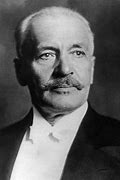
IGNACY MOŚCICKI
President Ignacy Mościcki was born on December 1, 1867 in Mierzanów. He studied chemistry at the University of Riga. In 1892, due to threats from the tsarist police, he left for London. Four years later, he was appointed assistant professor at the University of Fribourg in Switzerland.
He developed an original method of obtaining nitrogen oxide from the air, leading to the production of nitrogen compounds and ultimately the production of explosives. His research on nitrogen, however, was only one of the early achievements of engineer Mościcki. His most important inventions include high-voltage capacitors (first installed at the Eiffel Tower) and devices that protect electrical networks against lightning.
In 1912 he moved to Lvov, where he became a close friend and business partner of Marian Wieleżyński. Both men studied chemistry and were very active in their respective fields.
In 1916, at the initiative of prof. Ignacy Mościcki, at the headquarters of the companies Marian Wieleżyński and Władysław Szaynok (Lvov, ul. Sapiechy 3), a research and development company called “Metan” was established, with a capital of 100,000 crowns. Its main shareholder (50% of the capital) was owned by the company “Gaz Ziemny” of Marian Wieleżyński. Other partners included: I. Mościcki, W. Szaynok, J. Tomicki, K. Kling, S. Tołłoczko and others. The company conducted research in a narrow scope, mainly related to crude oil and natural gas that resulted in obtaining several patents in the fields of gas distillation and liquefaction.
In 1920, Marian Wieleżyński merged his various previously separate companies into a new company, “Gazolina SA”, based in Lvov. In 1922, after the closure of the Metan company and the transfer of its resources to the newly created Chemical Research Institute, Marian created his own new Gazolina research unit.
Ignacy Mościcki was a long-time collaborator of Józef Piłsudski, from the very beginning in the structures of the Polish Socialist Party. As a result of political changes in the mid-1920s, on June 1, 1926, the National Assembly elected Mościcki as President of the Republic of Poland.
In 1934, already as the President of the Republic of Poland, Ignacy Mościcki initiated a plan of enfranchising the employees of the “Community of Interests” group in Upper Silesia, that was taken over from the Germans, and which he entrusted to Marian Wieleżyński, the founder of Gazolina SA, the world’s first company operating on the basis of employee shareholding. Because of his age, the very mission of writing a report on the plan of this action was carried out by Marian’s son, Leszek Wieleżyński, a lawyer by training.
After Piłsudski’s death in 1935, President Mościcki was a leading moderate figure in the Polish authorities. He alleviated political and socio-economic difficulties and was able to pursue a policy of balance between two gigantic neighbors, trying to remain neutral, seeking and forging alliances with France, Great Britain and Romania. He remained president until September 1939, when he was interned in Romania by the Nazis. He decided to resign from the presidency and appointed the head of the Senate in Warsaw in his place. As a result, in December 1939, he was released from internment and moved to Switzerland, of which he was already a citizen. He returned to scientific work, but soon fell ill and died in his home near Geneva on October 2, 1946.
President Mościcki was a brilliant man who led a life in the service of society, first through his scientific work, its dissemination and implementation of its results in industrial applications, and then as a key political figure in Poland between the two world wars. In both endeavors, he was driven by the desire to make the world a better place.
